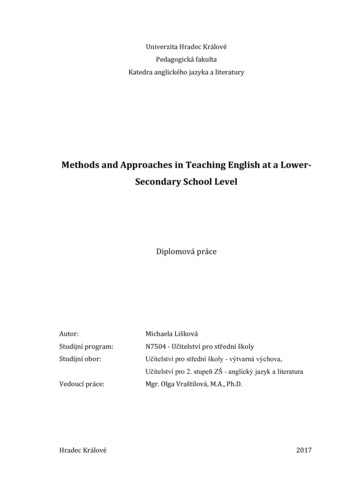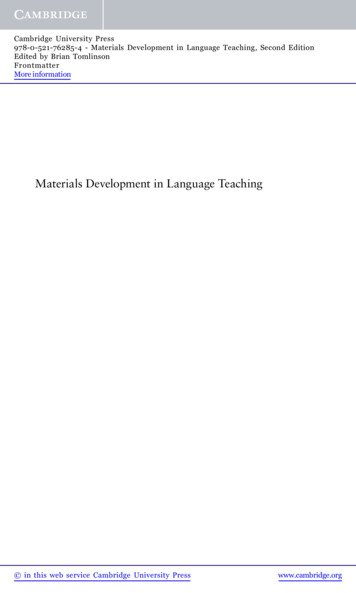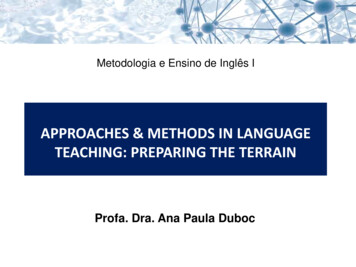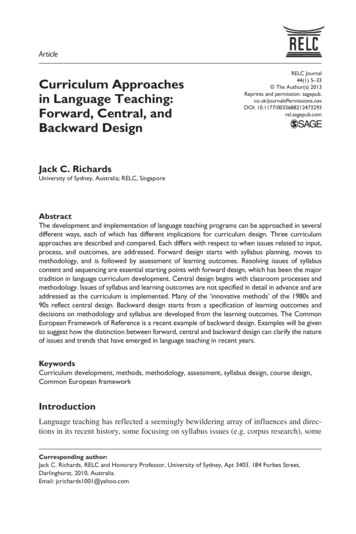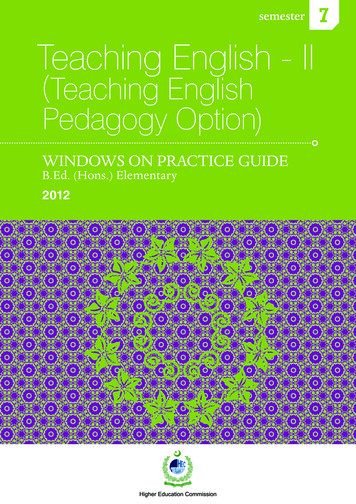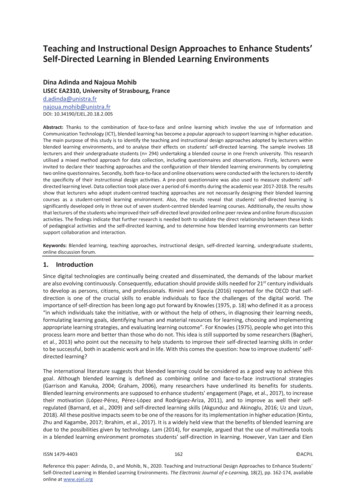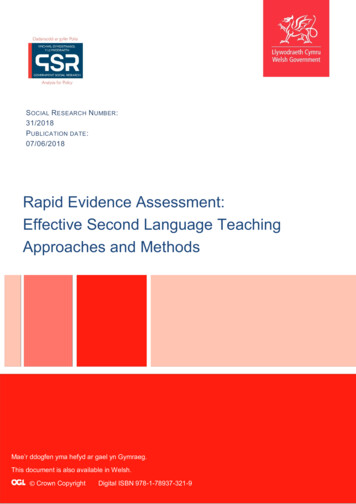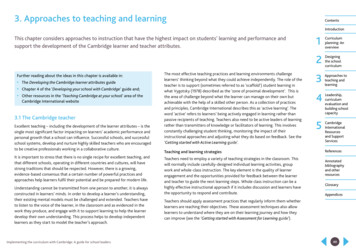
Transcription
International Journal of Humanities Social Sciences and Education (IJHSSE)Volume 4, Issue 5, May 2017, PP 123-129ISSN 2349-0373 (Print) & ISSN 2349-0381 15www.arcjournals.orgApproaches to the Teaching of Grammar: Methods andStrategies*Arm Mahbuber Rahman1, Md. Sumon Ahmed1¹Department of English, Khwaja Yunus Ali University, Sirajgonj, BangladeshAbstract: Every language has its grammar. Whether it is one’s own mother tongue or second - language thatone is learning. The grammar of the language is important. This is because acceptability and intelligibility, bothin speech and in writing within as well as outside one’s own circle or group depend on the currently followedbasic notions and norms of grammaticality. A knowledge of grammar is perhaps more important to a secondlanguage learner than to a native speaker has intuitively internalized the grammar of the language whereas thesecond – language learner has to make a conscious effect to master those aspects of the language whichaccount for grammaticality. It is, therefore, necessary for us, to whom English is a second – language, to learnthe grammar of the language. So, without the knowledge of the grammar of a particular language, we cannotproperly use the language in communication. But question may arise what should be the method and approachto the study of grammar. Several approaches have been followed through the ages for the study of Englishgrammar. The major approaches are the traditional approach, the structural approach, the notional- functionalapproach and the communicative approach.Keywords: English grammar, language, communication, approach1. TRADITIONAL APPROACHLanguage has been studied for centuries in ancient Greece, Rome, Arab, India etc. The word„traditional‟ is usually used to refer to the rendition of language study and writing grammars whichwas handed down to us from ancient Greeks. Through Rome and then, after Renaissance, throughother European languages which generally followed the Greek and Roman tradition. Traditionalgrammar also does not refer to any single author‟s or country‟s work. It was not as if a uniform, oridentical grammars were written or taught at that time. It refers to the general attitude of scholars ofthe time, to their specific methodology, their ways of looking at things. For example, the ideas aboutsentence and sentence analysis came from Aristotle and Plato (5th century B.C.): The stoic grammarshad written parts of speech, the scholastic philosophers of the middle Ages had speculated aboutmeaning, the concept of „correctness‟ came from the latter, eighteenth century grammarians ofEngland had ideas about the history of language deriving from the nineteenth century emphasis oncomparative philology.Before the eighteenth century the study of the English language was neglected. Preference was givento the classical languages such as Greek and Latin was the language of the church and of theuniversity and was widely used by the educated person throughout Europe. By the eighteenth century,however, the knowledge of the Renaissance had been translated into the language which everybodyspoke. This gradual use of English for affairs of state and literature and the invention of the printingpress generated a need for the study of grammar. The scholar should want to codify what they felt wasa disorderly language.These scholars believed in universal grammar- a perfect grammar of which individual grammar wascorruptions. (This belier in a universal grammar exists even today; this is because some grammaticalfeatures are shared by all languages). Because the educated Englishmen of the 18th century knewLatin so well that they naturally believed that that this classical language must be the closest to theuniversal grammar. The differences between English and Latin they considered as errors orcorruptions of English. The grammar text books of period, then were written to correct these errorsand to prescribe desirable usage. As Johnson says in the preface to his dictionary: ARCPage 123
Arm Mahbuber Rahman & Md. Sumon Ahmed“I have laboured to refine our language to grammatical purity, and to clear it from colloquialbarbarism, licentious idioms, and irregular combinations”.In order to establish a language as perfect, early grammarians obviously had to use Latin as a model tobuild as English grammar. Their difficulties were great, however, Latin and English differsignificantly from one another. In Latin morphology (word from) is far more important than syntax(word order). In English, syntax is more important than morphology. It is true that we alter word formEnglish too; „run‟ is changed into „ran‟ or „drive‟ into „drives‟. But we can understand an Englishsentence in which the usual form changes are not made; for example, there is no difficulty inunderstanding the sentences, “The engine of the car run well when he drives the car fast”. Theintended meaning of the sentence will not be grasped by us if our understanding depends primarilyupon word form. As it is, however, it makes sense though it sounds awkward.What is essential to our understanding of English is syntax or word order. The sentence “Engine wellruns the fast car of the drives the car he fast when” is unintelligible because its order is simple notcommon to the English language system. In Latin nearly the opposite is true. The form of most Latinwords is more important than their position.Generally, the failure to alter the form of Latin words results in confusion. But except for a few like„ad‟ and „cum‟, most Latin word do not have fixed places within a sentence.More problems appeared when the grammarians attempted to analyse English structures in two ways– some in terms of lexical meaning and others in terms of grammatical function.The most widely known definition of the sentence is based upon meaning:“A sentence is a group of word expressing a complete thought” But what exactly is a thought? And ifwe could define it how would we determine its completeness?Another popular definition is functional: “A sentence must have a subject which names a person,place, thing or idea, and a predicate which says something about the subject”. This explains aconstruction like “The child is crying”. But couldn‟t “the crying child” also fit the definition? Theword „child‟ names a person; and the word „crying‟ says the something about the child.For traditional grammarians, written language was both the aim and the basis of their work. There arefew or no rules for teaching spoken language. Spoken language is generally neglected. Pronunciationand suprasegmental feature find no mention in these grammars. The learners where asked to cram bynote memory rules of grammar and translate the language into the mother tongue or vice-versa. Whereused to be composition exercise, but no attention was paid to oral practice. The traditional grammarincluded rules and even vocabulary that may be more characteristic of written English. The rule forexample, phonetic. Morphology, syntax and semantics, But traditional grammarians, discussed withphonetics, phonemics, morphology and syntax. In this way we can see that the structured grammarwhich deals with one more topic which is known a semantics.2. STRUCTURAL APPROACHOne of the primary characteristics of structural grammar is its division of the study of the languageinto basic parts: structure and meaning. Usually, the structural grammar prefers to study thegrammatical forms or structures of the language before considering lexical meaning.Diagram1. Structural GrammarInternational Journal of Humanities Social Sciences and Education (IJHSSE)Page 124
Approaches to the Teaching of Grammar: Methods and StrategiesEnglish grammar in terms of structure is not as complicated as it seems. The native speakersremember learning lexical meanings because this takes place every time they encounter a new word.They do not learn grammatical signals because this happens early and informally in their lives. Butthe second language learner is not in the same position as the native speaker is. His internalization ofgrammatical to the structures though not complicated is through deliberate exposure to the language.That is why; he has to learn both lexical meanings and grammatical signals more or less at the sametime.3. NOTIONAL -FUNCTIONALThe term “functional-notional approach” embraces any strategy of language teaching that derives thecontent of learning from an initial analysis of the learner‟s need to express three different kinds ofmeaning: Functional (i.e. the social purpose of the utterance); Modal (the degree of likelihood);Conceptual – the meaning relations expressed by forms within the sentence (categories ofcommunicative function) .These method of language teaching is categorize along with others underthe rubric of a communicative approach. The method stresses a means of organizing a languagesyllabus. The emphasis is on breaking down the global concept of language into units of analysis interms of communicative situations in which they are used.Notions are meaning elements that may be expressed through nouns, pronouns, verbs, prepositions,conjunctions, adjectives or adverbs. A notion is a concept, or idea: it may be quite specific, in whichcase it is virtually the same as vocabulary (dog, house, for example); or it may be very general – time,size, emotion, movement – in which case it often overlaps with the concept of “topics”. A notion maybe “time past”; this may include past tenses, phrases like a month ago, in 1990, last week, andutterances using temporal clauses beginning with when ., before ., after . and so on;A function is some kind of communicative act: it is the use of language to achieve a purpose, usuallyinvolving interaction at least between two people. Examples would be suggesting, promising,apologizing, greeting, inviting.“Inviting” may include phrases like “Would you like to .? I suggest ., How about ? Please 4. STRATEGIES OF TEACHING GRAMMARThe strategies of teaching grammar depend on certain key areas of focus. These areas may beidentified with reference to the practice and use of grammar.PracticesDrillContextualized cluesCommunicativeUseCommunicative4.1. Practice: DrillDrills can be of the following types:Substitution TablesHeSheRajaRanihadatean applea bar of chocolatetwo ice creamsStructure TablesHeITheyyouShewriteswriteclearlya letter every daydetective novelscarelesslyInternational Journal of Humanities Social Sciences and Education (IJHSSE)Page 125
Arm Mahbuber Rahman & Md. Sumon naResponse: Romu is ten.:He‟ll be elevennext year.: Raghu is twenty.: He‟ll be twentyone next year.TeacherResponse: Baby likes: Baby doesn‟tLike bananas.: I like bananas.: I don‟t likeTennis4.2. Practice: Contextualized CluesIn this type of an exercise the context provides the clue to the type of grammatical item to be used.4.2.1. Now Response to the Following SituationsThe washing is outside and it starts to rain.Your father cannot understand a letter written in English.Your friend in says he‟s thirsty.4.2.2. Response to the Given SituationsA friend has come to see you in your house.Offer him something to drink.Situation: Thetelephone‟s (cue)ringing.Response: I‟ll answerit.You are in a post office. You need threestamps for a letter to the USA. What do yousay?4.2.3. Passages/Letter CompletionComplete the following letter using verbs in either the simple present or the present progressiveDear Bhanu,We (enjoy) our holiday a lot. Every day, we (walk) down to thebeach, (take) a dip the sea; (go) for a ride and(have) lunch at Tropicana.In fact, I (write) the letter from Tropicana. We (wish)you were here.LoveLata4.3. Practice: CommunicativeHere, the grammar to be practiced is based on information -gap or opinion – gap activities. Thegeneral framework is given, but the language is not controlled strictly.4.4. Communicative Question - Asking ActivityThrough fifteen yes/no questions, learners try to discover the person, animal or thing a learner cantake the oral of the teacher.Learner 1 : Are you alive?Teacher: No.International Journal of Humanities Social Sciences and Education (IJHSSE)Page 126
Approaches to the Teaching of Grammar: Methods and StrategiesLearner 2: Were you a man?Teacher: Yes.Learner 3: Did you really exist?Teacher: Yes.Learner 4: Were you an American?Teacher: No.Learner 5: Are you hungry?Teacher: No.Learner 6: Are you coming?Teacher: Yes.Learner 7: Do you agree?Teacher: No.Learner 8: Is he your brother?Teacher: Yes.Learner 9: Is she crying?Teacher: No.Learner 10: Was he famous?Teacher: Yes.Learner 11: Was she following?Teacher: No.Learner 12: Were you writing?Teacher: Yes.Learner 13: Does he know?TeacherLearner 14TeacherLearner 15Teacher: No.: Is she ill?: Yes.: Is he waiting?: No.5. EVALUATING GRAMMAR TECHNIQUESGrammar is a heavy subject. If we ask most teachers how they fell about it they respond with wordslike „boring‟ or „difficult‟ and they recount stories of student who ask for „more grammar‟ withamused resignation. Grammar with amused evil, without the high status afforded to other elements inhe curriculum such as communicative activities, reading, the use of videos and computers, etc.Grammar has had a chequered history in the evolving word of EFL teaching and learning. There wasa time, of course, when the study of grammar and techniques of translation were the main approachesto language learning. The Direct Method changed all that, however, and Audio- Lingualism (andstructural-situational methodology) made strenuous effect to disguise the grammar that was, in fact,being taught.Grammar‟s decline continued in the first flowering of the Communicative Approach, concerned itseemed to be with functional teaching and unstructured (in the linguistic sense) spontaneouscommunicative. But gradually the communicative movement has provoked a debate about exactlywhere grammar fits into the curriculum and the results of this discussion are now beginning to emergeas a renewed interest in, and emphasis on, the teaching and study of grammar in the general EFLclassroom.International Journal of Humanities Social Sciences and Education (IJHSSE)Page 127
Arm Mahbuber Rahman & Md. Sumon AhmedIn order to find out how teachers felt about various styles of grammar teaching a number workshopswere help in which teachers (and in least one case, student) were asked to assess a number oractivities (see below) in terms of where they fitted on lines between covert and over; student – centredand teacher-centred; creative and non-creative and finally helpful and unhelpful. What exactly dothese terms mean in this context?6. CONCLUSIONAmid the plethora of differed approaches, theories, grammar debates and discussions on theusefulness or otherwise of the teaching grammar what should be the standpoint of a teacher ofEnglish? Certainly he cannot do without grammar. Grammar is essential to second-language learning.As Wilkins observes:“The acquisition of the grammatical system of a language remains a most important element inlanguage learning. The grammar is the means through which linguistic creativity is ultimatelyachieved and an inadequate knowledge of the grammar would lead to serious limitations on thecreativity for communication. A notional syllabus, no less than a grammatical syllabus, must seek toensure that the grammatical system is property assimilated by the learner”.What Wilkins means is that grammar should be taught; without knowledge of the grammar of thelanguage, one‟s learning of the language is inadequate; conscious learning of grammar is slowlyconverted into an automatic process.Once it is recognized that the teaching a grammar is necessary but the question arises: how is it to betaught? In spite of the disagreements which exist between linguists regarding the relationship oftraditional, structural, notional-functional and communicative approaches. Some predict an eventualsynthesis of all these approaches to the study of languages. Each approach has made valuablecontribution to our knowledge of language and each has assimilated some of the facts and methods ofthe one preceding it. So we should be eclectic in our approach; we should be select is best suited forour purpose in the classroom. We need not have a whole hearted commitment to traditional grammar;nor should we reject outright the insights of modern linguists. We should select what is the best inthese approaches suited to the study of grammar. We should explain and describe grammatical aspectsof structure illustrate them with examples and lay down certain rules for our students‟ guidance andpractice. In other words, we should have our own approach based on a synthesis of the insights wehave gained from our study of the different approaches to the teaching of grammar.REFERENCES[1] Bright, J.A. & Macgregor, G.P. (1970).Teaching English as a second language. Longman, London.[2] Dubin, F. and Olshtain , E. (1991).Course design, development programmes and materials forlanguage learning .Canbirdge University press, New York.[3] Gurrey, P. (1996).Teaching English grammar. Longmans, London.[4] Kohli, A.L. (1997).Techniques of teaching English.[5] Dhankat Rai and Loyons J, (J.1971). An Introduction to theoretical lainguistics. Canbirdge:Canbirdge University Press.[6] Nagraj, G. (1996). English language teaching approaches methods techniques.[7] Palmer, F.R. (1990). Grammar. Penguin Books.[8] Penny, Ur. (1993). Grammar practice activities - A practical guide for Teacher. Cambridge:Cambridge University press.[9] Rajimwale, S. (1997). Elements of General Linguistics. Vol-1, Rama Brothers, New Delhi.[10] Robins, R.H (1985). General Linguistics- An Introductory Survey. Longman. London.[11] Rodriguez. R. and Ortega, R. Anglo American Studies. Vol. Villl, No. 1. April. 1998.[12] Verghese, C. P. (1998). Teaching English as a Second Language. Sterling Publishers, NewDelhi.[13] Harmer, J. (2007). The practice of English language teaching (4th Edition). Harlow: Pearson.[14] James, C. (1998). Errors in language learning and use: Exploring error analysis. London:[15] Addison Wesley Longman. Salem, I. (2007). The lexico-grammatical continuum viewed throughstudent error. ELT Journal 61/3: 211-219. Singleton, D. (2000). Language and the lexicon.London: Arnold.International Journal of Humanities Social Sciences and Education (IJHSSE)Page 128
Approaches to the Teaching of Grammar: Methods and Strategies[16] Carter, R., & Nunan, D. (2001). The Cambridge guide to teaching English to speakers of otherlanguages. Cambridge: Cambridge University Press.[17] Craik, F.I.M., & Lockhart. R.S. (1972). Levels of processing: A framework for memoryresearch. Journal of Verbal Learning and Verbal Behavior, 11, 671-684.[18] Doughty, C., & Varela, E. (2002). Communicative focus on form. In C.[19] Doughty & J. Williams (Eds.). Focus on form in classroom second language acquisition (pp.114138). Cambridge: Cambridge University Press.[20] Doughty, C., & Williams, J. (2002). Pedagogical choices in focus on form.[21] Ellis, R. (2002). The place of grammar instruction in the second/foreign language curriculum.[22] Wang, S. (2010). The significance of English grammar to middle school students in China.Journal of Language Teaching and Research, 1 (3), 313-319AUTHORS’ BIOGRAPHYARM Mahbuber Rahman, is a senior lecturer of English at KhwajaYunus AliUniversity in Bangladesh. He received his B.A &M.A degree in English fromAligarh Muslim University, India. His publications are „Students Attitudes towardsEnglish: The Case of Life Science School of Khulna University‟ (2012), „EnglishTeaching and Learning in the primary Levels in Sirajgonj‟ (2016).His researchinterests include English language Teaching, sociolinguistics, SLA.Md Sumon Ahmed, is a senior lecturer of English at KhwajaYunus Ali Universityin Bangladesh. He received his B.A &M.A degree in English from NorthernUniversity Bangladesh.His publication is „English Teaching and Learning in theprimary Levels in Sirajgonj‟ (2016). His research interests include Englishlanguage Teaching, sociolinguistics, SLA.International Journal of Humanities Social Sciences and Education (IJHSSE)Page 129
Approaches to the Teaching of Grammar: Methods and Strategies *Arm Mahbuber Rahman1, Md. Sumon Ahmed1 ¹Department of English, Khwaja Yunus Ali University, Sirajgonj, Bangladesh Abstract: Every language has its grammar. Whether it is one’s own mother tongue or
